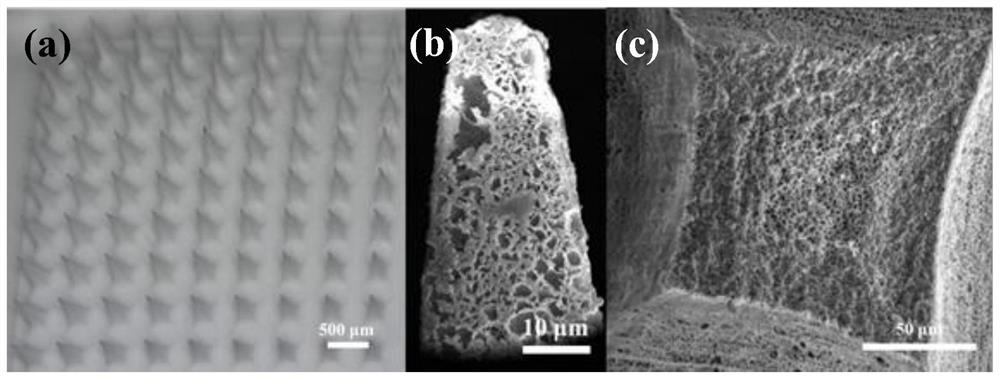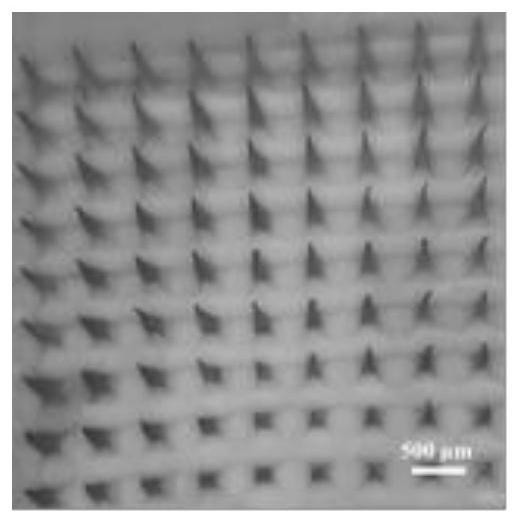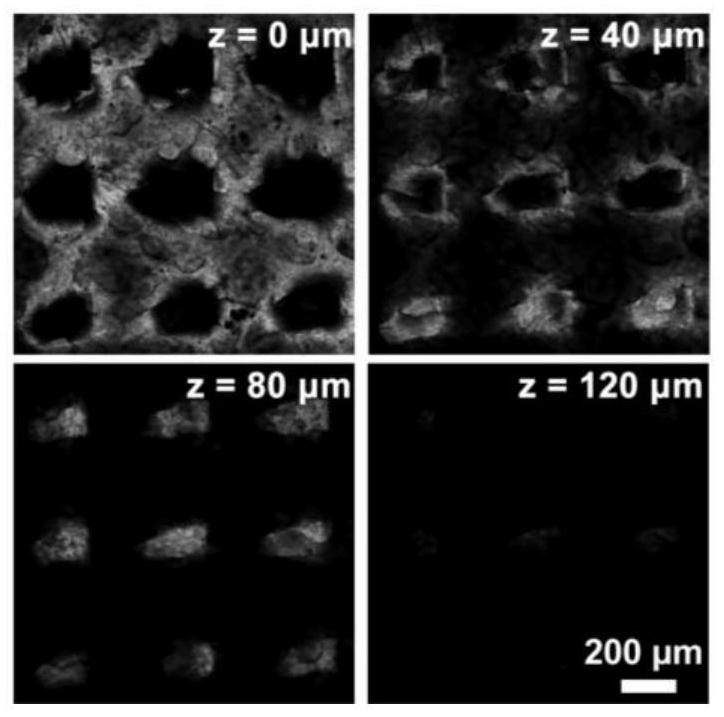A kind of microneedle capable of extracting skin tissue fluid and its preparation method
An interstitial fluid and microneedle technology, which can be used in inoculation and ovulation diagnosis, medical science, surgery, etc., can solve the problems of complicated microneedle preparation process, high preparation cost, and brittle preparation materials, so as to achieve no risk of fracture, no additional devices, and rapid Extracted effects
- Summary
- Abstract
- Description
- Claims
- Application Information
AI Technical Summary
Problems solved by technology
Method used
Image
Examples
Embodiment 1
[0037] First, use the microneedle positive mold to obtain the polydimethylsiloxane (PDMS) negative mold by the method of reverse replication, then, the dimethyl cellulose acetate with a molecular weight of 10KDa and a mass fraction of 25% (w / w) The sulfoxide solution was added dropwise to the negative mold (the porogen is the solvent dimethyl sulfoxide), ultrasonicated for 1 hour and then placed in ultrapure water at 25°C to cause phase separation of the polymer, and then freeze-dried to obtain a pore size of 1500nm , a porous microneedle with a porosity of 57% (mercury porosimetry) (base diameter 210 μm, height 600 μm, 10*10 array, the following examples are all parameters). Then use the microneedle with O 2Ion treatment, and alternately soaked in 1mg / mL chitosan and hyaluronic acid solution to obtain a 20nm thick hydrophilic layer, washed with pure water and dried, the water extracted from the agarose hydrogel within 10min of the microneedle The mass of 0.8mg.
Embodiment 2-5
[0039] By adjusting the mass percentage of cellulose acetate in the dimethyl sulfoxide solution, the size of the pores in the microneedles and the porosity of the microneedles can be further regulated, and the hydrophilic ability of the microneedles can be adjusted by adjusting the thickness of the hydrophilic layer. In addition, other types of polymers can be used instead of cellulose acetate to form microneedles corresponding to the polymer material, and the pore size and porosity of the microneedles can also be adjusted by controlling the ratio of the polymer to the porogen.
[0040] Based on Example 1, Example 2-5 can be adjusted, and the microneedle parameters in Example 2-5 are shown in the following table:
[0041]
Embodiment 6
[0043] First, the PDMS negative mold was prepared by the micro-template method; then, polyethersulfone and calcium oxide with a size of 2 μm were added to N,N-dimethylformamide at a mass ratio of 3:7 to prepare a solution, and the above The solution was added dropwise onto the PDMS female mold, and ultrasound was used to promote the solution into the mold; N,N-dimethylformamide was heated and dried, and the solid polyethersulfone microneedles containing calcium oxide were peeled off; the obtained solid microneedles were placed in 10 -4 In mol / L dilute nitric acid solution, calcium oxide nanoparticles are removed to obtain porous polyethersulfone microneedles with a pore diameter of 2000 nm and a porosity of 65%. Then use the microneedle with O 2 Ion treatment, and alternately soaked in 1mg / mL chitosan and polyacrylic acid solution to obtain a 20nm thick hydrophilic layer, washed with pure water and dried, the microneedle within 10min from the water extracted from the agarose h...
PUM
| Property | Measurement | Unit |
|---|---|---|
| thickness | aaaaa | aaaaa |
| pore size | aaaaa | aaaaa |
| pore size | aaaaa | aaaaa |
Abstract
Description
Claims
Application Information
 Login to View More
Login to View More - R&D
- Intellectual Property
- Life Sciences
- Materials
- Tech Scout
- Unparalleled Data Quality
- Higher Quality Content
- 60% Fewer Hallucinations
Browse by: Latest US Patents, China's latest patents, Technical Efficacy Thesaurus, Application Domain, Technology Topic, Popular Technical Reports.
© 2025 PatSnap. All rights reserved.Legal|Privacy policy|Modern Slavery Act Transparency Statement|Sitemap|About US| Contact US: help@patsnap.com



